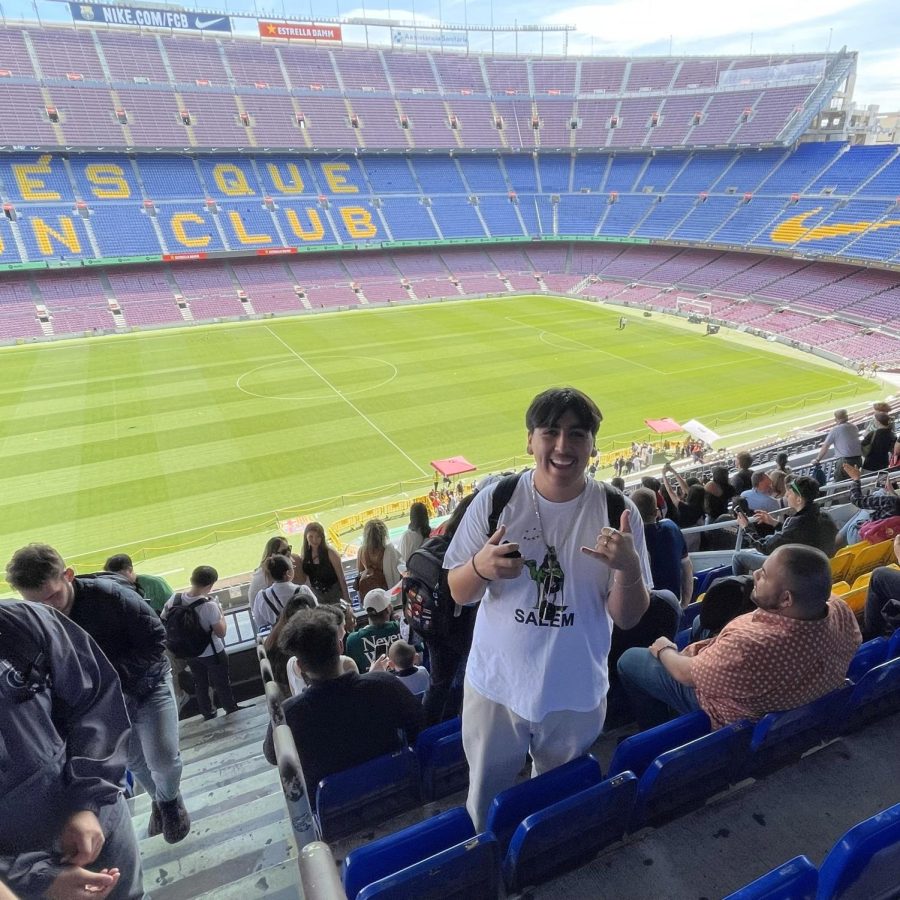My Travel Guide: Spain
While taking an in-depth tour of the Camp Nou stadium in Barcelona, I felt a rush of joyful emotions, as it was a childhood dream to see it in person.
Spain. It’s a beautiful country in the Southwestern part of Europe, filled with vivid cities and historically enriching cultures, however it can be a lot to take in for first time travelers. From the high-end stores in Madrid to the blacksmith sword shops in Toledo, Spain is a constant sprawling environment that cherishes its tourists.
Over this past spring break I had the opportunity to travel to Spain for the first time with the Salinas Valley Dream Academy. Traveling to a foreign country for 11 days vastly altered my perspective of the world outside Salinas. This experience personally meant a lot for me and I knew that I wanted to write about it so here are my biggest takeaways, tips, and general advice when visiting Spain for the first time.
Starting off with the flight. In my opinion, the best option is to buy a one way flight. I really enjoyed my experience at SFO, as it was very smooth and the flight service was top tier making the flight enjoyable. One way flights usually cost less than round trips. While some may disagree and proclaim that a round-trip ticket is better, I think that it isn’t. One way tickets are usually in the $350 range while round-trip tickets vary in the $550 range. However, I still recommend direct flight tickets as moving from city to city, it’s better to buy a ticket leaving from the last city visited rather than the city the trip started from as it’s more convenient. Ending the trip in Barcelona and having to go all the way back to Seville can be done via the nation’s bullet train. However, the average ticket costs $150, add that to the round trip ticket cost and it adds up to $700, the same if one were to buy two one-way tickets.
I recommend starting the trip in Seville, the heart of southern Spain and the capital of the Anda Lucia region. Seville isn’t a bustling city environment compared to the other Spanish cities, but it is still full of history and culture that allows visitors to ease into the Spanish way of life.
The air in Seville is heavy and the weather is tolerable, meanwhile the architecture is warm and loves to pop out. A lot of the buildings, including Seville’s bullfighting ring, are colored in white and yellow making them easily noticeable from a long distance away. Close to the bullring is ‘Plaza de Espana’ which is a wide open area consisting of mosaic wall art, gothic style towers, a row boat attraction, horse-drawn carriages, and a beautiful fountain in the middle of it all. Moving further into the city of Seville, there’s the Cathedral of Seville. The cathedral is a tall, gothic style church and visitors have the opportunity to climb the bell tower which has an amazing view of the whole city. The cathedral is home to the tomb of Christopher Columbus and other historic Christian novelties. Ultimately,Seville is a quaint area in the southern part of Spain definitely worth visiting. The hotel where I stayed was Hotel Sevilla Congresos, which I undoubtedly recommend. The hotel usually charges around $260 a night for a room with two beds, a bathroom, balcony, and room service. Although most hotels in Spain are smaller in comparison to the United States, the Hotel Congresos offers plenty of room and a spectacular view of the city’s atmosphere.
Parting ways with Seville and going northeast we end up in Spain’s capital, Madrid. The hotel I recommend for this portion of the trip is Hotel Chamartin The One. Hotel Chamartin costs an average of $180. Being in a more popular tourist destination, the hotel costs less than its competitors due to its location, being the outskirts of Madrid. The hotel’s entrance can be tricky to locate as it is actually underground. Hotel Chamartin is rated four stars and serves breakfast and dinner everyday and offers breathtaking views of the lively city of Madrid.
Madrid is a sprawling landscape of gothic architecture and modern technological advancements. Madrid is known for it’s high fashion with a lot of big name brands having their own stores in Madrid’s long street strips. Alongside the strips, is the Estadio Santiago Bernabeu, home to the most successful soccer team in Spain, Real Madrid. While the stadium is currently going through renovations, visitors still have the pleasure of stopping by the store and even taking a tour through the team’s impressive trophy room. Moving away from the urban areas of Madrid, one can find themself in Retiro Park. Retiro Park spans 300 acres and is home to 15 thousand trees, a beautiful lake, and an oddly placed glass house among other countless areas to traverse and discover. Madrid’s centro is in between its royal palace (Palacio Real) and the city’s theater (Theatro Real) which have both gone through countless renovations in an attempt to keep their original pristine. While Madrid has a lot of boisterous areas, being Spain’s capital it is home to the national post office, Parliament, and Spain’s biggest flag among other important landmarks. Lastly, Madrid is home to a vast subway system spanning nearly 300 stations across the entire city of Madrid which has become an integral part of the city’s ecosystem.
Departing from Madrid and heading to Barcelona is a whopping seven hour car ride, so what I recommend is using the national metro system home to high speed, state of the art bullet trains which only cuts the time from seven to two hours. A direct train ticket from Madrid to Barcelona averages a cost of $50-$60 dollars, while direct plane flights usually cost around the same. However, the bullet trains offer comfortable seating, a snack bar, and a gorgeous view of Spain’s countryside while only lasting two hours as opposed to the seven hour via car ride. The hotel I recommend for Barcelona is Hotel SB Diagonal. Hotel Diagonal costs an average of $150 and suffers from the same effect as Hotel Chamartin, that being that it is really far from Barcelona’s main attractions. However, it offers roof access to see the overarching city, a gym in the basement, and the rooms are more spacious compared to other hotels in Spain.
Barcelona’s atmosphere is very different from Madrid, as Barcelona is a coastal city and its architecture is very different from Spain’s other cities. The buildings in Barcelona more often than not are reminiscent of Renaissance era Italian architecture with a lot of the same color being used such as maroon, velvet, and cream.
The city is home to Spain’s second largest soccer club, FC Barcelona. Its stadium, Camp Nou, offers an in-depth tour of the team’s trophy room, locker room, and even allows visitors a view of the field from both the stands and courtside.
Further along into the city is the architectural masterclass, Cathedral La Sagrada Familia. The cathedral is intricately carved to tell Biblical stories all alongside its high concrete pillars. Standing at a whopping 566 feet, La Sagrada Familia is clearly visible from mostly all over the city and is in fact still under construction rumored to be completed in 2026.
Next, Barcelona’s university (Universitat de Barcelona) is the city’s university having its own clock tower and cathedral whilst the classrooms look like they belong in royal castles. The cathedral in and of itself has an interesting history seeing as it was taken over and used as a Nazi war room. Overall, Barcelona offers amazing sights from the vast ocean to the towering Sagrada Familia Cathedral that cannot be found anywhere else in Spain.
Spain is notorious for its pickpockets, so be wary of the environment and take extra precautions in order to avoid being pickpocketed. A good tip is to carry one’s backpack in front of them and to keep important items in their front pocket rather than their back pocket. Another tip to take into heavy consideration is what one is wearing, in specific soccer jerseys. Spain is home to one of the biggest soccer leagues in the world and every team has their fair share of over the top fans. Wearing the wrong team’s jersey and being at the wrong place at the wrong time can lead to stressful situations to say the least. In general, always knowing where one is at is crucial because being lost in the wrong part of town can end up being very dangerous.
Spain uses Euros as its currency. One can find a lot of places where they exchange US dollars to Euros. Also, a lot of places accept credit cards and offer the ability to pay in dollars or Euros with said card.
Lastly, in Spain everyone smokes, and I mean everyone. The air quality in Spain is very poor due to all the smoking that happens on a daily basis, so it always smells of cigarettes and the floor is always littered with cigarette butts.
The country of Spain is beautiful in many ways once one delves into the culture, the people, the locations. I’d say it is very underrated when compared to other European countries. I definitely see myself visiting in the future and I hope that whoever reads this also has a chance in the future to visit the beautiful country that is Spain.
Your donation will support the student journalists of Alisal High School. Your contribution will allow us to purchase equipment and cover our annual website hosting costs.













